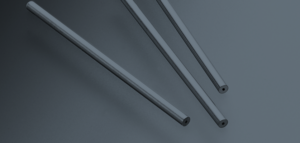When a Stamped Spacer Is Just Not Good Enough
Once upon a time — more than 20 years ago — a large automobile manufacturing company came up with a great idea for their fuel injection system: They invented a flap that opened and closed like a heart valve, to alternately meter fuel out and seal to keep fuel in. To go with this new flap valve, the company needed a seal ring with thickness, flatness, and parallelism dimensions controlled to micron tolerances.
Specifically, the auto manufacturer wanted a small, perfectly flat ring that would form a surface that mates precisely to the flap’s surface and seals tightly so that no fuel would escape when the flap was in the closed position. The spacer’s surface would need to resist getting dirty in order to maintain a tight seal and prevent fuel from leaking into the injection system. It would also need to withstand billions of cycles, with repeated opening and closing of the flap.
The auto company was looking for a very thin, washer-like metal ring that was less than 0.050” thick and had flatness, squareness, and parallelism tolerances in the microns in order to prevent any surface distortion. The spacer also needed to perform flawlessly no matter what temperatures it was subjected to — from freezing cold to blistering engine heat. In addition, the company needed millions of these spacers and wanted them at a low cost!
Related Article: Your Tight Tolerance Could Be Seriously Affecting Part Cost
The Precision Stamping Options
It turns out, achieving a perfectly flat spacer ring was a real challenge, and the automaker struggled with finding a part they were confident would not distort under engine conditions.
First, the automaker went to a precision stamping company for the manufacture of the spacer. Stamping the ring out of a sheet initially seemed like the perfect method, producing a flat part with a horizontal grain. However, in testing, the part could not maintain its flatness, with some curving always occurring along the body; additionally, the part’s stamped edge would have deformation.
Next, the automaker tried a supplier that would make the spacer rings through fineblanking, a precision metal-forming process that is a hybrid of the stamping and cold extrusion methods. Fineblanking utilizes a triple-motion hydraulic press and specially designed tooling to produce parts with fully sheared, straight-cut edges.
For the automaker’s spacer application, the fineblanking method produced a more cleanly sheared perimeter than conventional precision stamping. However, in addition to having a somewhat higher cost than conventional precision stamping, fineblanking did not produce a flatness that could be maintained over time. The automaker also discovered that the grain direction of these processes was causing them life-testing problems.
Third Option’s the Charm
Finally, the automaker came to Metal Cutting to explore other options for achieving the right distortion-free flatness, sharp edge, and exterior diameter for their spacer ring. We took a different approach than the previous vendors, suggesting the use of tubing — either extruded or using a solid rod or larger tube drawn though a die to achieve the correct ID — to produce a ring that was then precision-cut to the proper thickness required for the spacer.
Unlike stamping and fineblanking, precision cutoff produced a grain structure in the tube’s drawn direction that reduced the chance of warping over time when compared with a flat grain. Where stamping and fineblanking could cause pulling and burrs where the material was sheared, precision cutoff produced sharp corner radiuses. Capable of providing burr-free cutoff of very thin materials with no end deformation or distortion, precision cutoff also held tight tolerances while delivering the dimensions the automaker needed for its very thin spacer.
In the end, precision cutoff proved to be the “happily ever after” option for this application. While up front the process would not be as inexpensive as stamping or fineblanking, the cost was well worth it when compared with the expense of replacement had the automaker’s revolutionary flap been installed with a spacer that was destined to fail — not once, but millions of times.





